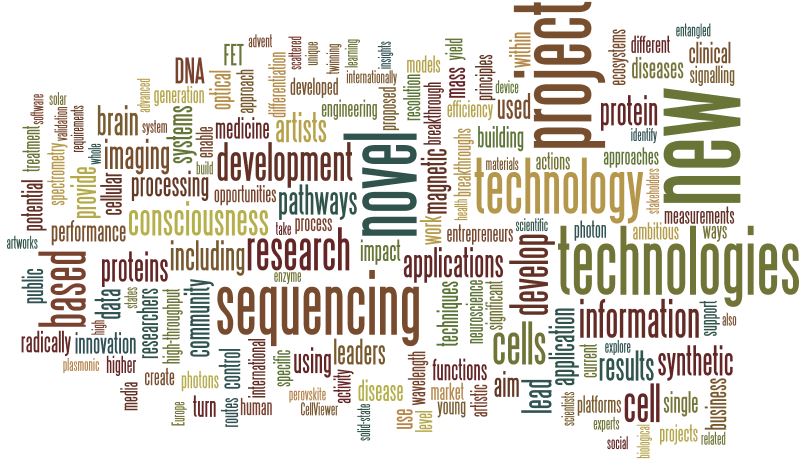FET-Open: Second cut-off projects have started

date: 05/02/2016
FET-Open Research and Innovation Actions
BREAKBEN sets out to picture the dynamics of human brain function at unprecedented resolution and reliability. By using new multimodal techniques it will be possible to link accurate magnetic measurements of neural activity with near-simultaneous high-definition measurements of brain structure.
CellViewer seeks to visualize in single cells with nanoscale resolution macromolecules such as proteins and genetic information carriers (DNA, mRNA) in parallel and at the systems level. This will permit to study the mechanisms of self-renewal and differentiation of mouse embryonic stem cells and consequently to predict stem cell changes resulting from specific input stimuli.
FutureAgriculture proposes an efficient metabolic bypass for photorespiration in plants which leads to the loss of CO2 and consequently to reduced growth yield. Using new enzyme based synthetic pathways to bypass photorespiration has the potential to significantly increase the photosynthetic efficiency, supporting higher yields of crop, a pressing need for a continually growing world population.
GOTSolar aims to develop the next generation of solar cells, solid-state perovskite solar cells (PSCs). Transparent and available in various colours PSCs will significantly broaden the traditional solar cell application area. Perovskite solar cells will be highly efficient, long-lasting and environmentally safe, which would make them a sustainable power source not only from the harvesting but also from the production point of view.
LIAR (Living Architecture) plans to develop a programmable bioreactor able to extract valuable resources from waste water and air and to generate oxygen, proteins and fibre. Its possible installation in domestic, public and office settings will significantly improve the environmental performance of our living spaces with undeniable benefits for health, productivity and ecosystems.
LUMINOUS will study, model, quantify, and alter those aspects of consciousness that can be observed. Based on computational neuroscience the project aims to create non-invasive consciousness-probing technologies to analyse brain activity. This will provide key insights in natural and artificial cognition research and greatly impact conditions such as locked-in syndrome and other disorders of consciousness.
MAGNEURON proposes a radically new concept for remote control of cellular functions by means of magnetic manipulation. Magnetic nanoparticles functionalized with proteins will be implanted into target cells, where they can be controlled by external magnetic fields. Possible applications are cell replacement therapies for neurodegenerative diseases, such as Parkinson’s disease, or brain injuries.
MARA will develop cost-effective, autonomous DNA sensors and “DNA origami”-based molecular robots for the detection and destruction of cells. Multidrug resistant bacterial pathogens will be used as model system for the first proof-of-concept because alternative treatments of infectious diseases are essential to contain their further spread.
MSmed targets proteomics, i.e. the large-scale study of proteins, particularly their structures and functions. By developing the kind of mass spectrometry so robust and powerful that it will be present in every biological laboratory and in every clinic, the project will radically improve future diagnosis, interpretation of disease mechanisms and drug action.
PROSEQO envisages novel technologies which will substantially advance protein and DNA sequencing. This might eventually radically transform patient treatment, enabling precise monitoring of disease response to therapeutics at the molecular level.
SUPERTWIN intends to develop the technology for an advanced optical microscope with a resolution well beyond the current state-of-the-art for high resolution imaging. Compact, portable, superresolution microscope techniques, with no moving parts and no requirements to the optical properties of the sample are the envisaged application for this new quantum imaging technology.
FET-Open Coordination and Support Actions
FEAT gives international artists the opportunity to gain first-hand insight into cutting-edge science by spending time with FET researchers on site. In addition to initiating stimulating collaborations between arts and sciences, the project aims at reaching out to diverse audiences for FET research.
BrainHack intends to organize the international artistic community experimenting with Brain/Neural Computer Interaction (BNCI) and to link it to the BNCI scientific community. Hackathons will be used as a platform to stimulate learning and exchange between artists, scientists and BNCI technology providers.
FET2RIN aims at facilitating collaborations between FET researchers, entrepreneurs, for the commercial take up of FET project results. The project's goal is to deliver capacity building actions to FET project partners also with the help of crowdfunding to bridge the gap between the development of an innovative product and its use by early adopters.
FET-Open call statistics* for the 2nd cut-off:
RIA: 11 / 670 (1.6%)
CSA: 3 / 20 (15%)
Of note, number of proposals below threshold(s): 339 (RIA) and 7 (CSA)
(*) Number of proposals retained for Grant Agreement preparation / Number of submitted proposals
More information:
Funded projects from the first and third cut-off 2014/2015 and from the first cut-off 2016/2017.
